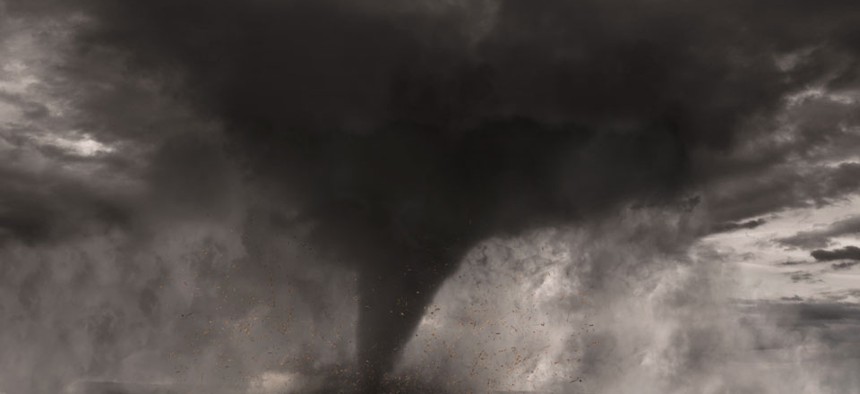
sdecoret/Shutterstock.com
The Shutdown Will Slowly Reduce Our Weather Preparedness
Resources are still working, but all maintenance on them has halted.
On Monday afternoon, a line of storms hundreds of miles long crossed the Appalachians and struck cities on the Eastern seaboard. Earlier that day, tornado watch was issued, stretching from New York City to Washington, D.C., that lasted until 5 p.m.; broadcasts and web journalists picked up the news and transmitted it to millions in the affected region.
Most people who heard about that tornado watch learned about it from journalists and journalist-meteorologists who work at private media companies. But, perhaps without realizing it, everyone who heard about it depended upon the meteorologists, one level down and less visible, who work for the National Weather Service, a program of the National Oceanic and Atmospheric Administration.
Americans, in other words, rely daily on the “vibrant public-private-academic partnership” that exists in the United States around weather, according to Dr. J. Marshall Shepherd, president of the American Meteorological Society. Every part relies on every part — and every part is suffering for the shutdown.
In a special blog post, Shepherd unfolds how the shutdown is damaging American meteorology. It’s easy to think, he writes, that “well, we are still getting our weather forecasts and warnings, and I still have the information from TV.”
But this, he says, is deeply naïve.
"Private sector companies and broadcast stations," he says:
are essential partners in the weather enterprise. However, most of the satellite, Doppler radar, and observational data are from federal sources. The major forecast models are run at NOAA facilities. Federal predictions centers and Forecast Offices issue warnings. I can’t imagine a major potato chip maker saying that it could survive without potato farms. The point herein is that there is a vibrant public-private-academic partnership and each component is essential.
(Emphasis mine.)
Those resources are still working, but all maintenance on them has halted. Many employees working at them have stopped being paid. American weather news depends on the American government.
But it goes beyond the news. Marshall proceeds to inventory what he sees as the cascading consequences of the shutdown. Some consequences are technical, he says: The United States might fail to develop weather models to rival Europe’s. The shutdown might exacerbate the upcoming, possible gap in functioning government weather satellites.
Other consequences are practical. Current meteorological research has paused, for lack of available weather data, Marshall writes, and new research can’t secure funding:
Research is also being impacted because many valuable datasets from NASA, NOAA, and other agencies are not available. I personally have one project on hold because I cannot access a valuable dataset from NASA. One colleague also correctly notes that NSF and many scientific granting agencies are unable to process grants to universities. This means that students, which depend on the grants for their financial support, may be without funding.
Worst of all, Marshall believes, are the systemic consequences:
One recent doctoral student shared the following with me, “I recently completed my PHD and applied for a NASA Postdoctoral program…..They were supposed to give me an answer by October. Since NASA is shutdown my life is also shutdown and with it all my dreams of continuing a career as a researcher. As a young scientist who want to serve and contribute to science this is just frustrating….” This comment should be a big red flag because I am hearing more and more from our best and brightest students that they want to avoid the federal sector because of the lack of support/respect, restrictions on travel to critical meetings, and the prospect of having to working “pro-bono”. We are jeopardizing our future if our best young talent is already making such assessments.
And finally, the shutdown destabilizes federal scientists who have been furloughed like it destabilizes anyone else. Like hundreds of thousands of federal employees, they work on the “promise of pay”—and with anxiety.
Many of our weather colleagues at NWS, National Hurricane Center, and FEMA (some called back after multiple weather threats appeared last week in the U.S.) are working on the “promise of pay”. Even with the “promise of pay”, one thing that is promised is that their mortgage is still due, kids will still get sick, and groceries are needed now.
(Image via sdecoret/Shutterstock.com)
NEXT STORY: 5 Reasons the Shutdown is the New Normal







